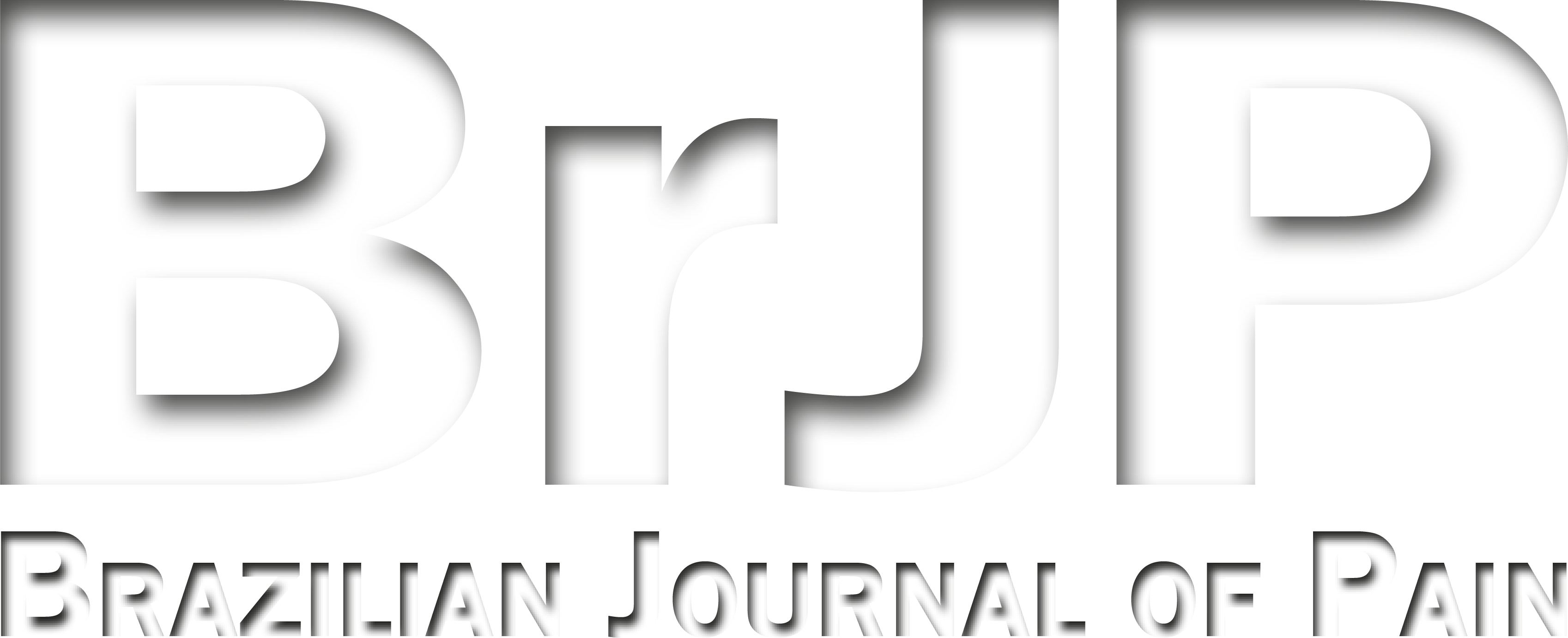Aussie current in students with chronic neck pain: a randomized controlled trial
Corrente Aussie em estudantes com cervicalgia crônica: um ensaio clínico randomizado
Bruna Caroline da Silva; Camila Amaral Coracini; Carla Lautenschleger Branco; Mayara Doneda Michelon; Gladson Ricardo Flor Bertolini
Abstract
Keywords
Resumo
Palavras-chave
References
Delfino PD, Rampim DB, Alfieri FM, Tomikawa LC, Fadel G, Stump PR. Cervicalgia: reabilitação. Acta Fisiatr. 2012;19(2):73-81.
Silva AF, Costa MA, Soutinho RS, Pedrosa AS. Prevalência de cervicalgia em acadêmicos de odontologia de um Centro Universitário. Rev Port Saúde e Sociedade. 2017;2(2):422-34.
Sprung CL, Silvério-Lopes S. Utilização de técnicas da medicina tradicional chinesa (MTC) para analgesia da cervicalgia em adultos: revisão sistemática. Rev Bras Terap e Saúde. 2016;7(1):7-15.
Neves RH, Lima VA, Maria RA, Sant'Ana HG. Modalidades terapêuticas no tratamento e prevenção da dor muscular tardia - revisão de literatura. Ciências Biológicas e Saúde Unit. 2017;4(1):147-58.
Zeng C, Li H, Yang T, Deng ZH, Yang Y, Zhang Y. Electrical stimulation for pain relief in knee osteoarthritis: systematic review and network meta-analysis. Osteoarthritis Cartilage. 2015;23(2):189-202.
Ward AR, Robertson VJ. Variation in torque production with frequency using medium frequency alternating current. Arch Phys Med Rehabil. 1998;79(11):1399-404.
Ward AR, Chuen WL. Lowering of sensory, motor, and pain-tolerance thresholds with burst duration using kilohertz-frequency alternating current electric stimulation: part II. Arch Phys Med Rehabil. 2009;90(9):1619-27.
Ward AR, Lucas-Toubourou S. Lowering of sensory, motor, and pain-tolerance thresholds with burst duration using kilohertz-frequency alternating current electric stimulation. Arch Phys Med Rehabil. 2007;88(8):1036-41.
Ward AR, Oliver WG, Buccella D. Wrist extensor torque production low-frequency and burst-modulated kilohertz-frequency currents. Phys Ther. 2006;86(10):1360-7.
Cook C, Richardson JK, Braga L, Menezes A, Soler X, Kume P. Cross-cultural adaptation and validation of the Brazilian Portuguese version of the Neck Disability Index and Neck Pain and Disability Scale. Spine. 2006;31(14):1621-7.
Acedo AA, Antunes AC Luduvice, Santos A Barros dos, Oliveira C Barbosa de, Santos C Tavares dos, Colonezi GL. Upper trapezius relaxation induced by tens and interferential current in computer users with chronic nonspecific neck discomfort: an electromyographic analysis. J Back Musculoskelet Rehabil. 2015;28(1):19-24.
Dissanayaka TD, Pallegama RW, Suraweera HJ, Johnson MI, Kariyawasam AP. Comparison of the effectiveness of transcutaneous electrical nerve stimulation and interferential therapy on the upper trapezius in myofascial pain syndrome: a randomized controlled study. Am J Phys Med Rehabil. 2016;95(9):663-72.
Facci LM, Nowotny JP, Tormem F, Trevisani FV. Effects of transcutaneous electrical nerve stimulation (TENS) and interferential currents (IFC) in patients with nonspecific chronic low back pain: randomized clinical trial. São Paulo Med J. 2011;129(4):206-16.
Resende L, Merriwether E, Rampazo ÉP, Dailey D, Embree J, Deberg J. Meta-analysis of transcutaneous electrical nerve stimulation for relief of spinal pain. Eur J Pain. 2018;22(4):663-78.
Kawamura H, Nishigami T, Yamamoto A, Tsujishita M, Ito K, Ohya N. Comparison of the pain-relieving effects of transcutaneous electrical nerve stimulation applied at the same dermatome levels as the site of pain in the wrist joint. J Phys Ther Sci. 2017;29(11):1996-9.
Maayah M, Al-Jarrah M. Evaluation of transcutaneous electrical nerve stimulation as a treatment of neck pain due to musculoskeletal disorders. J Clin Med Res. 2010;2(3):127-36.
Park C, Choi JB, Lee YS, Chang HS, Shin CS, Kim S. The effect of intra-operative transcutaneous electrical nerve stimulation on posterior neck pain following thyroidectomy. Anaesthesia. 2015;70(4):434-9.
Corrêa JB, Costa LO, Oliveira NT, Lima WP, Sluka KA, Liebano RE. Effects of the carrier frequency of interferential current on pain modulation and central hypersensitivity in people with chronic nonspecific low back pain: a randomized placebo-controlled trial. Eur J Pain. 2016;20(10):1653-66.
Oliveira L, Mota C, Lima L, Abner T, Agripino M, DeSantana J. Effect of different times of administration of transcutaneous electric nerve stimulation (TENS) on the duration of its hypoalgesic effect. J Pain. 2014;15(^sSuppl 4):S102.
Venancio RC, Pelegrini S, Gomes DQ, Nakano EY, Liebano RE. Effects of carrier frequency of interferential current on pressure pain threshold and sensory comfort in humans. Arch Phys Med Rehabil. 2013;94(1):95-102.
Agripino ME. Efeito hipoalgésico da corrente alternada de média frequência em quilohertz (Aussie) em indivíduos saudáveis: ensaio clínico randomizado. 2017.
Pereira GD, Cassolato KM, Lazarin PH, Canto TO, Portolez JL, Bertolini GR. Interferential current effect, 2000hz, on the induced pain threshold. Rev Bras Med Esporte. 2011;17(4):257-60.
Moberg LL, Lunde LK, Koch M, Tveter AT, Veiersted KB. Association between V̇O-2max, handgrip strength, and musculoskeletal pain among construction and health care workers. BMC Public Health. 2017;17(1):272.
Mysliwiec A, Saulicz E, Kuszewski M, Kokosz M, Wolny T. Assessment of the influence of Sauders traction and transcutaneous electrical nerve stimulation on hand grip force in patients with neck pain. Ortop Traumatol Rehabil. 2011;13(1):37-44.
Pereira A, Ogliari P, Debiazi P, Pacini VC, Picanço VV, Carvalho AR. Análise da influência da manipulação na coluna vertebral sobre a força de preensão palmar e limiar de dor. Ter Man. 2011;9(43):278-83.
Bautista-Aguirre F, Oliva-Pascual-Vaca Á, Heredia-Rizo AM, Boscá-Gandía JJ, Ricard F, Rodriguez-Blanco C. Effect of cervical vs. thoracic spinal manipulation on peripheral neural features and grip strength in subjects with chronic mechanical neck pain: a randomized controlled trial. Eur J Phys Rehabil Med. 2017;53(3):333-41.
Krueger-Beck E, Nogueira-Neto GN, Neves EB, Nohama P. Potencial de ação: do estímulo à adaptação neural. Fisioter Bras. 2011;24(3):535-47.
Submitted date:
03/12/2018
Accepted date:
06/27/2018


